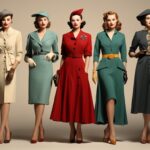In the ever-evolving landscape of fashion, one of the most fascinating transformations has been the evolution of workwear for women. From the constrained and often impractical attire of the past to today’s modern, empowering outfits, women’s workwear has gone through a remarkable journey. This article delves into the history and transformation of workwear for women, highlighting the key milestones and trends that have shaped the way women dress in professional settings.
The Early Days: Corsets and Long Skirts
Corsets and Constricting Fashion
The late 19th and early 20th centuries were characterized by the dominance of corsets in women’s fashion. These undergarments were designed to create an hourglass figure by tightly cinching the waist. While fashionable, they were incredibly uncomfortable and impractical for most work settings. Women were expected to wear corsets even while working, making it challenging to perform tasks that required mobility and comfort.
The Influence of World War I
The First World War brought significant changes to women’s workwear. With men serving in the military, women were called upon to take their places in factories and offices. This shift in roles demanded more practical and comfortable clothing. Skirts began to shorten, and looser-fitting blouses and dresses became more popular as women needed greater freedom of movement to fulfill their new roles. The corset gradually faded from fashion as functionality took precedence over aesthetics.
The 1940s and 1950s: A New Era of Professional Attire
The Rise of the Power Suit
The post-World War II era marked the rise of the power suit for women. Inspired by men’s suits, these ensembles featured tailored jackets with padded shoulders and knee-length skirts. Women in the workforce sought clothing that projected authority and professionalism, and the power suit became a symbol of this ambition.
The Influence of Hollywood Icons
Hollywood played a significant role in shaping women’s fashion during this period. Icons like Audrey Hepburn and Marilyn Monroe introduced the world to the charm of well-fitted dresses and pencil skirts. These glamorous styles became synonymous with sophistication, influencing the wardrobes of working women everywhere.
The 1960s and 1970s: A Time of Revolution
The Rise of Pantsuits
The 1960s and 1970s brought a revolutionary shift in women’s workwear with the advent of pantsuits. Women like Coco Chanel and Yves Saint Laurent challenged the status quo by introducing tailored pantsuits for women. This marked a significant departure from traditional skirts and dresses and allowed women greater comfort and versatility in the workplace.
The Feminist Movement and Androgynous Styles
The feminist movement of the 1960s and 1970s played a crucial role in reshaping women’s workwear. Women were no longer content with simply mimicking men’s attire; they wanted clothing that allowed them to express their identity and challenge traditional gender norms. Androgynous styles became popular, blurring the lines between what was considered “men’s” and “women’s” clothing.
The 1980s and 1990s: Corporate Fashion Takes Center Stage
Power Dressing and Shoulder Pads
The 1980s were defined by the concept of power dressing. Women in corporate settings sought clothing that exuded authority, often characterized by oversized shoulder pads, bold colors, and sharp silhouettes. The power suit evolved to include shoulder-padded blazers and knee-length skirts, reflecting the ethos of the corporate world at the time.
Casual Fridays and the Rise of Business Casual
The 1990s brought a more relaxed approach to work attire with the introduction of “Casual Fridays.” Companies started allowing employees to dress down on Fridays, leading to the popularization of business casual attire. This shift in workplace culture allowed women to incorporate more comfortable and casual elements into their workwear while maintaining professionalism.
The 21st Century: Diversity and Personal Expression
Inclusivity and Diversity in Fashion
The 21st century has seen a significant focus on inclusivity and diversity in fashion. The fashion industry has started recognizing the importance of offering a wide range of sizes and styles to cater to women of all body types and backgrounds. This shift has empowered women to express themselves more freely through their work attire.
The Influence of Technology
Advancements in technology have also had a profound impact on women’s workwear. The rise of remote work and video conferencing has led to a greater emphasis on the upper half of outfits, with blouses and tops taking center stage while bottoms may remain casual. The “Zoom shirt” has become a popular term, highlighting the changing priorities in work attire.
Modern Workwear: Empowerment and Choice
The Blend of Comfort and Style
Today, women have more choices than ever when it comes to workwear. The rigid dress codes of the past have given way to a more flexible approach that blends comfort and style. Women can choose from a wide range of options, from traditional business attire to casual chic, depending on their workplace and personal preferences.
The Influence of Sustainable Fashion
Sustainability has also become a significant consideration in modern workwear. Women are increasingly opting for eco-friendly and ethical fashion brands that prioritize sustainable materials and practices. This shift reflects a growing awareness of environmental issues and a desire to make more responsible choices in clothing.
The Intersection of Fashion and Gender Equality
Fashion has long been a reflection of societal norms and values, and its impact on gender equality cannot be overstated. The intersection of fashion and gender equality has evolved significantly over the years, shaping and reflecting women’s changing roles and expectations in society.
Historically, fashion often perpetuated gender stereotypes and limitations. Women’s clothing was designed to conform to traditional roles and expectations, with corsets and constricting garments symbolizing the constraints placed on women. However, as women began to challenge these norms, fashion became a powerful tool for advocating gender equality.
In the mid-20th century, fashion started to play a pivotal role in the feminist movement. Women like Coco Chanel and Yves Saint Laurent broke away from conventional norms by introducing androgynous styles that blurred the lines between “men’s” and “women’s” clothing. This shift allowed women to express themselves more freely and challenged traditional gender roles.
In recent years, the fashion industry has become increasingly aware of its role in promoting gender equality. Many fashion brands have embraced inclusivity and diversity, featuring models of different genders, body types, and backgrounds in their campaigns. This change reflects a more inclusive vision of beauty and empowers individuals to embrace their unique identities.
Furthermore, fashion designers and brands are championing gender-neutral and unisex clothing lines, breaking down the rigid boundaries of traditional gendered attire. This move provides greater choice and flexibility and sends a message of acceptance and support for diverse gender identities.
In conclusion, the intersection of fashion and gender equality is a dynamic and evolving one. Fashion has the power to challenge and transform societal norms, making it an essential ally in the ongoing pursuit of gender equality. As the fashion industry continues to adapt and evolve, it has the potential to inspire and empower individuals to break free from traditional constraints and express their true selves.
The Role of Fashion Designers
Fashion designers play a pivotal role in shaping the way people dress and perceive themselves. Their creative vision, innovation, and ability to anticipate and adapt to cultural shifts profoundly impact the world of fashion and, consequently, society as a whole.
Fashion designers are the architects of style, responsible for creating clothing and accessories that reflect the spirit of the times. They are cultural interpreters, translating societal trends, values, and aspirations into tangible garments and designs. Their ability to capture the zeitgeist often defines an era’s fashion aesthetic.
Historically, iconic fashion designers have reshaped the way we view gender, class, and identity. Visionaries like Coco Chanel and Yves Saint Laurent challenged conventional gender norms by introducing androgynous styles and pantsuits for women. Their designs revolutionized fashion and paved the way for greater gender equality and self-expression.
In addition to influencing cultural narratives, fashion designers are catalysts for change within the industry itself. They push boundaries by experimenting with materials, silhouettes, and production techniques. Many contemporary designers embrace sustainability, champion ethical practices, and promote diversity and inclusivity in their collections. These efforts reflect a broader awareness of environmental and social issues, driving meaningful change in the fashion industry.
Fashion designers are also trendsetters who inspire and guide consumer choices. Their runway shows and campaigns set the tone for what’s considered fashionable, impacting consumer behavior and influencing the choices individuals make when selecting their attire.
In conclusion, fashion designers occupy a central position in the fashion ecosystem, serving as cultural interpreters and change agents. Their designs influence how we dress, challenge societal norms, promote inclusivity, and drive the industry toward a more sustainable and responsible future. Their role extends beyond aesthetics; it encompasses social, cultural, and ethical dimensions that shape the world of fashion and, in turn, our broader society.
Conclusion: From Constriction to Empowerment
The evolution of workwear for women is a testament to the changing roles and expectations of women in society. From the restrictive corsets of the past to today’s empowering and diverse choices, women’s workwear has come a long way. It reflects changing fashion trends and the broader cultural shifts and movements that have shaped our world.
As we move forward, it is essential to continue celebrating the freedom and choice that modern workwear offers. Whether it’s a classic power suit, a comfortable pantsuit, or a sustainable and stylish ensemble, women today have the power to express themselves and project their confidence and competence in the workplace, proving that what we wear can reflect our empowerment and individuality.











